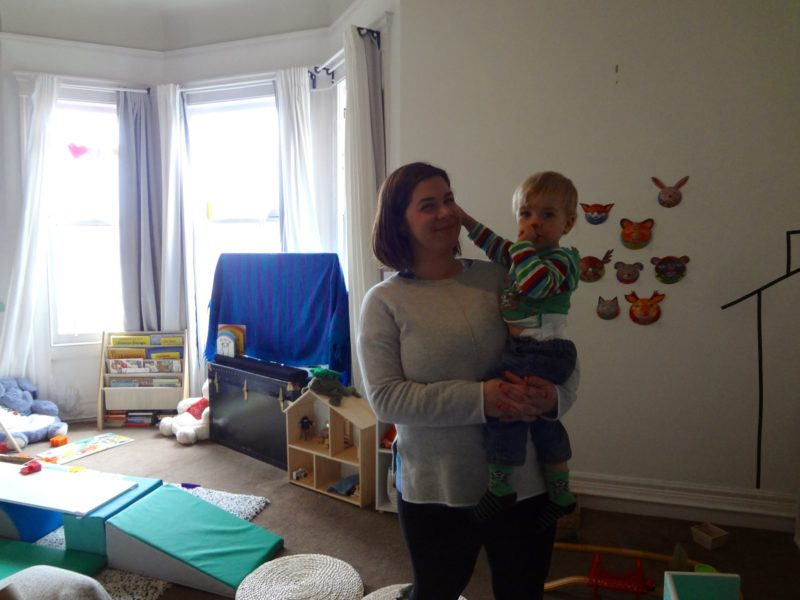
Meredith Bunyard in her home-based child care in San Francisco. Rachel M. Cohen for The Hechinger Report
By Rachel M. Cohen | May 2, 2019
SAN FRANCISCO — Meredith Bunyard, 34, always knew she wanted to run her own preschool. The San Francisco resident graduated from nearby Mills College in May 2018 with a master’s degree in early childhood education, and today she is getting her dream off the ground with the help of a new child care services company called Wonderschool.
Wonderschool is one of a recent crop of child care startups that aim to make it easier to open and operate home child care businesses and easier for parents to find those businesses once they launch. The idea is to assist child care providers with their bookkeeping, licensing, marketing and curriculum offerings, all generally for a 10 percent cut of the revenue. All Wonderschool providers sign a two-year contract; those who opt not to renew their contract still owe Wonderschool a year’s worth of fees for each child the company helped them recruit.
The companies’ pitch to potential home-based child care providers? Avoid high real estate costs of running a preschool center by doing it in your home. We’ll help you with the business and marketing side of things and show you how to write off nearly all your business expenses. And we’ll help you seamlessly fill your open slots with new children.
It’s not yet clear this model will work, as none of the companies championing it are more than a few years old. Moreover, child care is a low-revenue business with tight profit margins, which raises the question of whether these businesses can really make money while helping providers earn more.
The median annual salary for a child care worker in 2018 was just $23,240, according to the Bureau of Labor Statistics. Wonderschool’s CEO, Chris Bennett, said recently that he believes his company can help the owners of home-based child care programs earn $120,000 a year. That would be a more than five-fold increase to the median.

Wonderschool CEO Chris Bennett at the start-up’s San Francisco headquarters. Rachel M. Cohen for The Hechinger Report
Bennett is gambling that by offering providers business support, his company can make home-based child care more financially sustainable and attractive to owners, thereby creating more viable child care options for parents.
“We just want to provide so much value for you that you’re just like, ‘Why would I ever switch?’” said Bennett of his approach to convincing child care providers to use Wonderschool.
And if supply goes up because more people are willing and able to run successful home-based child care programs, he bets the cost of care will eventually come down.
“There’s a huge child care shortage, which is a big reason why we started this company in the first place,” he said.
Not everyone thinks it’s a good idea.
Wonderschool is “counting on the fact that you’re ignorant and not connected to anyone,” said Pat Sullivan, board president of the Family Child Care Association of San Francisco which offers support to local providers and advocates for their interests. “Most providers in California are low-income,” Sullivan said. “We are the lowest paid part of the teacher workforce, so for us to pay 10% of our income for something we could get virtually for free is absolutely not a good idea.”
Sullivan is also doubtful start-ups like Wonderschool will bring down the cost of child care, as the two biggest cost drivers — wages and real estate — will continue to go up.
Whether or not the model works will be proven by providers who, like Bunyard, are among the first to take these companies up on their offers of help in exchange for a cut of earnings.
Back at Bunyard’s sunny apartment in the affluent Alamo Square neighborhood of San Francisco, students arrive each day, ready to play with the blocks, books and other toys she has stocked in cubbies lining the walls.
Bunyard has five students now, who come on a staggered schedule so that there are never more than four in her apartment at a time. Her website lists prices ranging from $1,320 per month to $2,400 per month. She’s already taking home about $6,000 a month after paying all of her expenses, except rent, which she splits with her long-term boyfriend. If those numbers stay consistent, she’ll earn $70,000 per year.
Bunyard would like to grow her business slowly and plans to serve six kids a day, the maximum her license allows, by the summer. Even though she could legally watch six children by herself, Bunyard plans to hire a co-teacher to help her out. While her business income may increase a bit when she starts serving six children, she said most of the additional tuition dollars will go toward her co-teacher’s salary.
Bunyard first learned of Wonderschool through a Craigslist ad.
“I found them in June, and they were like, ‘We can have you up and running by August,’” she said. Bunyard credits Wonderschool with helping her build a website, take professional photographs, create a Yelp listing, and price her services, among other start-up tasks. “The idea of running the business was overwhelming for me and Wonderschool was very open to all the kinds of questions that I had,” she explained.
Bunyard can connect with Wonderschool staff and other providers on Slack, an online chat app, and has access to virtual professional development opportunities. There are also social gatherings for providers in San Francisco, as well as in-person meetings with a Wonderschool advisor.
Teachers are very secluded. I’m by myself all day working with children,” Bunyard said. Wonderschool is “not just a business; they’re creating a community of teachers and schools.”
Related: To boost preschool quality, Massachusetts invests in college degrees for teachers
Wonderschool has captured the enthusiasm of Silicon Valley investors as well, raising over $24 million in its first two years. Most of that cash — $20 million — came from Andreessen Horowitz, the influential venture capitalist firm co-founded by Marc Andreessen, the creator of Netscape and an early investor in tech successes including Skype, Facebook, Twitter and Airbnb.
In 2018, Wonderschool reported it had 140 child care businesses spread across San Francisco, Los Angeles and New York City, with program directors earning an average of $78,000 a year. But by 2019, Wonderschool would share neither how many businesses it works with nor its child care directors’ average salary. “It’s just like, private information,” said Bennett in response to The Hechinger Report’s request for updated data.

Children playing at Rachele Long’s home-based child care in San Francisco. Rachel M. Cohen for The Hechinger Report
Another new company proposing to help home-based providers run better businesses is WeeCare, which launched in Los Angeles in 2017. Its leaders are already eyeing expansion to cities in other states, said co-founder Jessica Chang. “Earn up to $100,000/year doing what you love,” their marketing materials say.
Providers who sign up for WeeCare get access to a curriculum developed in-house, and are encouraged to use it. Those that do are ranked higher on WeeCare’s app. WeeCare also offers help with business tasks including licensing and billing and, like Wonderschool, offers mentorship and the chance to be part of a community of providers.
WeeCare hopes to open a million home-based child care locations over the next decade. To meet that goal they’d have to launch 100,000 new businesses per year from now until 2029. As of February, the start-up had about 150 providers signed up for its services.
Chang said her company seeks to serve lower-income families, but both WeeCare and Wonderschool have so far primarily reached higher-end markets. As of December 2018, only 12% of Wonderschool families paid for child care with government vouchers, which are regulated by states and are usually only available to families making less than the state median income. Approximately 30% of WeeCare families pay with vouchers. Both startups said they are working on initiatives to increase the number of providers who serve low-income families.
In the Mountain West, a company called MyVillage is offering yet another version of the new business model. MyVillage offers providers assistance setting up and running their businesses, a suite of curricula to choose from, discounts on supplies, access to specialized bookkeeping software and up to two years of intensive mentorship with a local provider, said co-founder Erica Mackey. Her goal is to help providers run a business that works as an “average American family solution” to child care by keeping the cost affordable for families.
Right now, there are roughly 20 MyVillage preschools scattered across Colorado and Montana charging an average monthly price of $900 for full-time child care. Mackey said she’d like MyVillage to sign up over 100,000 new providers in the next 10 years. That would be an average of 10,000 new providers per year. For context, Colorado currently has 5,034 licensed child care facilities, according to that state’s data. Montana has fewer. Mackey said her company’s expansion plan includes the rest of the country.
“We see this as a nationwide thing — rural, urban, suburban areas, with everything from high-end suburban homes to double-wide trailers,” she said.
Currently, home-based child care can be found in all of those settings. Families often choose home-based care because it is less expensive than center-based care. Year-round, full-time infant care in a center-based program costs more than 10 percent of a couple’s median income in 43 states and the District of Columbia, according to Child Care Aware, a nonprofit advocating for affordable and accessible child care. Costs are similarly high for 4-year-olds, for whom center-based tuition costs more than 10 percent of median income in 24 states.
Related: Regulations for child care hard to roll back, as Trump proposed, because there aren’t many
Home-based child care is also far less regulated than center-based care. In 24 states, for instance, there is no minimum education requirement at all for opening a home-based child care, according to a report by the Center for the Study of Child Care Employment at the University of California, Berkeley. Despite the lack of requirements, low wages, among other factors, led to a sharp decline in the number of home-based child care providers between 2010 and 2016, according to the Committee for Economic Development of The Conference Board, a public policy think tank.
The goal for Wonderschool, WeeCare and MyVillage, their leaders said, is to help existing providers make more money and to convince potential new providers the business is worth giving a shot. All three companies also offer curricular materials in the hope of helping providers improve the quality of their programs.
Yet another new child care services start-up, Pie for Providers, focuses exclusively on business management tools, not curriculum. Clients get access to the Pie for Providers app, which can be used on a computer or a phone, to help them collect payments, track expenses and stay on top of licensing deadlines and regulations. They can also sign up for text-message reminders to keep them on track. And, unlike Wonderschool, WeeCare and MyVillage, the business primarily targets child care providers working with low-income families who pay for child care with government subsidies.
According to Pie for Providers co-founder Chelsea Sprayregen, as of March, 82 child care providers were using the service. While Sprayregen and her team originally envisioned charging home child care workers a cut of their revenue, like WeeCare and Wonderschool, they’ve since changed course. In 2019, they decided to make their services free to providers who work with up to 20 children, while charging larger child care centers. They also plan to sell data on items like how often providers are paid on time, or how many days it takes for government reimbursement checks to come through to unions, government agencies, consulting firms and other large organizations. Sprayregen said they realized they could not expand quickly enough selling to individual home-based providers in such a fragmented market and so switched their revenue model to focus on bigger players.
Related: Few preschool apps are developmentally appropriate, report finds
While all these new startups have vast ambitions for national growth — it remains to be seen how long providers will stick with them once they get the hang of running their own businesses.
Some longtime child care providers doubt the relationship will last. Family Child Care Association’s Sullivan has run her own home preschool in San Francisco since 1992. She thinks startups like Wonderschool exploit the anxieties of new providers who aren’t familiar with the business ins-and-outs.
“I think it’s predatory,” she said. “Especially when they talk about helping someone get licensed. That’s really a much more simple process than people realize.”
Sullivan said the idea of paying Wonderschool upwards of $14,000 for business assistance each year, about what she calculates she would owe, is crazy.
To make her point, she tallied up her annual business costs: $9 for a website, $400 for an accountant, $300 for HiMama, an app that helps providers communicate with parents and manage administrative tasks like billing, and about $2,000 for insurance. She said she also set up her own free account on Yelp. That’s less than $3,000 a year, or less than a quarter of what she’d have to pay Wonderschool.
“I do my own bookkeeping because I only have 10 kids,” Sullivan added. “It takes me like zero time to invoice people and it’s really not a big deal at all.”

Rachele Long at her home-based child care in San Francisco. Rachel M. Cohen for The Hechinger Report
Rachele Long, another Wonderschool provider, lives in the wealthy Cow Hollow neighborhood of San Francisco in a house Bennett, Wonderschool’s CEO, found, leased, and now subleases to Long. Her two-year Wonderschool contract includes an agreement to move out within thirty days if she no longer wants to run a home-based child care program in the house. But her contract ends at the end of June and when her lease renews in July, it will be under her name, not Wonderschool’s.
Bennett declined to reveal how many other providers he subleases to.
“It was a test of a ‘pilot program’ of sorts, that if we feel [is] successful, we will plan to share publicly, but are still evaluating it as a scalable offering at this time,” said Kimberly Angell, Wonderschool’s spokesperson.
Long and her two co-teachers care for 12 children, with monthly tuition ranging from $2,121 to $2,365 per child. Long said she earns $65,000 a year in salary and is able to pay her employees between $45,000 and $53,000.
“I am making about 52% more now as an owner and director compared to when I was a pre-K teacher in a center-based program,” Long said by text.
Stories like this are part of what makes businesses like Wonderschool exciting to Louise Stoney, a consultant and co-founder of the Alliance for Early Childhood Finance, which studies financial models for the child care industry. Stoney thinks these businesses can help providers achieve what she calls the “Iron Triangle” of a successful child care business — full enrollment, collecting payments in full and on time, and having tuition high enough to cover costs.
“Those three things are really hard to do, and it’s harder when you have a personal relationship with the people you serve,” she said.
A 10% cut for the companies is reasonable, in Stoney’s view, because she estimates many child care providers leave between 15 to 25% of potential revenue on the table by not filling open slots quickly enough, not claiming all the available tax deductions, or other lapses. “I honestly believe that with efficient management, it’s a win-win for everyone,” she said.
All Our Kin, a Connecticut-based nonprofit, has provided free support to family child care providers since 1999, offering guidance on running high-quality businesses. The organization’s co-founder, Jessica Sager, thinks there’s “a lot of potential” for online platforms in early childhood and said solutions that can help providers balance their students’ educational needs with their responsibilities as business owners are a good thing. But she said she worries about providers, especially those who serve low-income families, not being able to afford such services.
“We do know the early child care system is really subsidized on the foregone wages of its workers and we know family child care providers are really making so many financial sacrifices, so we want to understand where these increased profits are going to come from,” said Sager. “I am very nervous about taking dollars away from providers.”
This story about in home child care was produced by The Hechinger Report, a nonprofit, independent news organization focused on inequality and innovation in education. Sign up for our newsletter.
